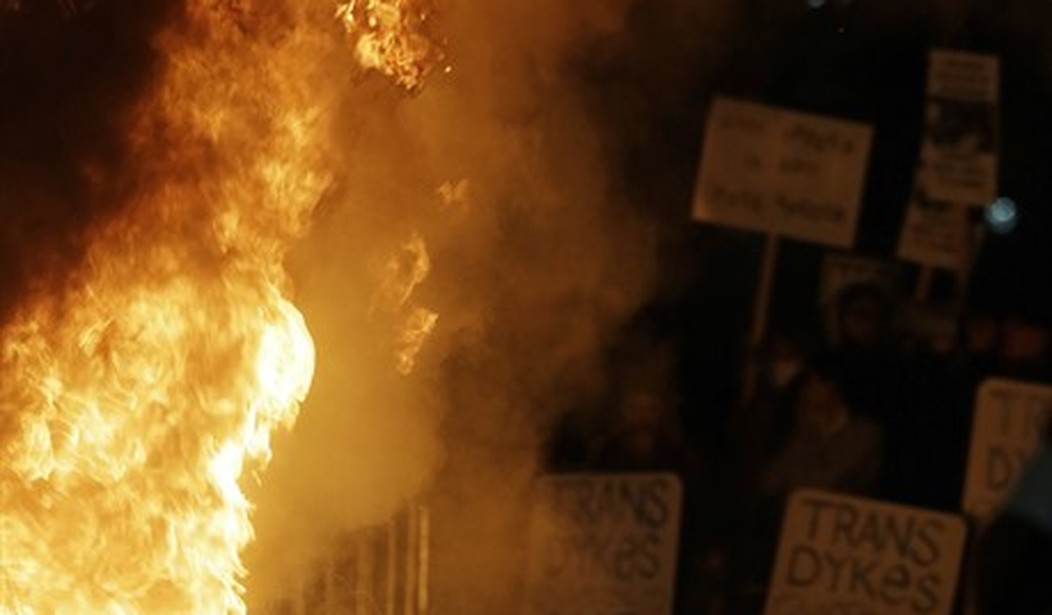There is more than one way to demolish a book, to vaporize the carrier and symbol of enlightenment, though historically fire was the preferred method, otherwise known as the Auto-da-Fé. Originally referring to the burning of heretics at the stake, the practice was extended to obliterating the humanistic inventory of knowledge, culture, and community resources.
Perhaps the most famous historical instance was the partial and then final burning of the celebrated library in Alexandria over three separate occasions: 48 BC (by Julius Caesar, according to Plutarch); 391-415 AD (often attributed to Christian rioters); and 640 AD by a Muslim army. As Edward Gibbon recounts, upon learning of a great library containing all the knowledge of the world, the conquering general supposedly asked the Caliph for instructions regarding the Library’s holdings. He replied, “They will either contradict the Koran, in which case they are heresy, or they will agree with it, so they are superfluous.” In any case, though remnants survived, the Library essentially ceased to exist.
The destruction of the great library in Baghdad in 1258 was not by fire but by water, which amounts to the same thing. Legend has it that when the Mongols laid siege to Baghdad, the library’s entire collection of manuscripts and books was thrown into the Tigris. The river is said to have run black with ink for seven days.
A famed European instance has given us the phrase “bonfire of the vanities” — of which there were many such cremations over the years — instigated by the Dominican friar Girolamo Savonarola in Florence in 1497. He sponsored several of these “bonfires of the vanities” where classical books and works of art were burned, including manuscripts, sculptures, paintings, musical instruments, gaming tables, nude statues, harmless trinkets, beauty products, and anything considered a work of art.
Savonarola, writes Richard Cavendish in History Today (v. 48, Issue 5, May 1988), “grimly disapproved of jokes and frivolity, of poetry and inns, of sex (especially the homosexual variety), of gambling, of fine clothes and jewellery and luxury of every sort. He denounced the works of Boccaccio, nude paintings, pictures of pagan deities and the whole humanistic culture of the Italian Renaissance. He called for laws against vice and laxity. The friar also disapproved of profiteering financiers and businessmen. He put an end to the carnivals and festivals the Florentines traditionally enjoyed, substituting religious festivals instead, and employed street urchins as a junior gestapo to sniff out luxurious and suspect items.” (One thinks of the recent looting spree in Philadelphia of high-end commercial establishments, whose perpetrators NBC Philadelphia dismissed as “mostly consisting of juveniles.” Though, of course, the motives of the junior gestapo and the Philly juveniles vary.)
Nicoló Machiavelli in his “History of Florence” calls Savonarola a “plebian prince [who] persuaded the people of Florence that he spoke with God and did not have to report to the magistrates,” thus exonerating the preacher on the grounds of political expedience in his effort to remake society. His fire was a burnt offering to the Lord. This, however, was not the consensus. Francesco Guicciardini’s “The History of Florence” provides a more reasonable account of Savonarola’s career and its aftermath, a book well worth escaping the flames.
The modern age does not lack for spectacular book burnings, such as those carried out by the Nazis in the 1930s when books of all genres and subjects by Jewish authors were heaped in large pyres and set aflame to the great delight of the multitudes. Repressive regimes live and die by the Auto-da-Fé.
As Orwell writes in “1984” about the totalitarian state Oceania, “Every record has been destroyed or falsified, every book rewritten, every picture has been repainted, every statue and street building has been renamed, every date has been altered. And the process is continuing day by day and minute by minute. History has stopped. Nothing exists except an endless Present in which the Party is always right.” Newspeak alters the truth in publications and on radio, just as political correctness, the legacy media, and digital platforms routinely do today, with little critical awareness among large swaths of the population. In the Afterword to the 1961 edition of the book, Erich Fromm aptly warns of a society “of automatons who will have lost every trace of individuality, of love, of critical thought, and yet who will not be aware of it because of ‘doublethink’.”
We have seen today that libraries can be “burned” by electronic means as well, that is, the cyber destruction of information via censorship, spurious fact-checking, and what is known as “deletionism.” Muniments can suddenly be made to disappear from one moment to the next. Equity-based book-weeding has become a favored device of school boards in purging their libraries according to categories like inclusivity, relevance, diversity, cultural responsiveness, and date of publication — all forms of a so-called “equitable curation cycle.” The Peel District School Board in Toronto, for example, has sent Harry Potter packing, and, even worse, Anne Frank’s “Diary of a Young Girl” is not to be found. A diversity audit is as good as a five-alarm fire.
Culture critic Mark Tapson observes, “For all of the Left’s shrill, false charges that conservatives are frenzied, anti-intellectual book-banners, it is the totalitarians of wokeness who are actively engaging in the online stealth editing of classic fiction, the mob cancellation of insufficiently woke authors, and the quiet culling of books from library shelves to accommodate the ideological requirements of ‘equity’ and ‘inclusion.’ Although the aforementioned ‘equity’ book weeding policy was implemented in Canada, make no mistake—a similar woke targeting of the West’s literary heritage will be coming to school libraries in America, if it hasn’t already, and possibly even to public libraries and bookstores as well.”
Not to be outdone, government-mandated “book burning” proceeds under cover of democratic law, as Canadian author, journalist, and director of Rebel News, Ezra Levant, discovered when his book “The Librano$: What the Media Won’t Tell You about Justin Trudeau’s Corruption,” came under the shadow of Trudeau’s RCMP just prior to the October 2019 election. Levant was targeted for contravening sections 352 and 353 of the Canada Elections Act which requires third parties to register during a federal election. The ruling manifestly does not apply, as the Act states, to published books and “does not include…the distribution of a book, or the promotion of the sale of a book, for no less than its commercial value, if the book was planned to be made available to the public regardless of whether there was to be an election.”
In his recent legal challenge against Trudeau’s censorship policy, Levant found himself facing seven federal lawyers to his one as well as a compliant judge who, Levant writes, “didn’t really think it was a big deal for authors to be summoned by police to explain what their ‘plans’ were for publishing political books. It wasn’t too much of an imposition, she implied.” This is what should be expected in a totalitarian state masking as a democracy, for which Canada has become the world’s poster boy. One way or another, an Auto-da-Fé is in play.
Related: Is Canada a Tyranny? Aristotle on Justin Trudeau
Similarly, the Canadian Radio-television and Telecommunications Commission (CRTC) has announced new regulations that will expand control over what Canadians will see, hear, and broadcast over the internet. Under the powers vested in the telecommunications office by Prime Minister Justin Trudeau’s Bills C-11 and C-18, online streaming services will be regulated.“The regulatory anaconda will squeeze slowly,” warns former CRTC National Commissioner Timothy Denton, “but will squeeze tightly.” As the Western Standard points out, “from [government] involvement, it is but a short walk to influence and then control.” Public ignorance of the real world around us is the purpose behind these repressive measures.
Clearly, there is more than one way to “burn” a book, to cauterize history and incinerate truth. Richard Weaver in “Visions of Order” is very clear on this point. What we are witnessing is “the cultivation of amnesia,” the filtering of the meaning behind current events and the elimination of the past, that leads to the death of “intellectual responsibility.” “I do not find any other period,” he writes, “in which men have felt to an equal degree that the past either is uninteresting or is a reproach to them.” When we realize the extent to which cultural memory is being erased, “we are made to wonder whether there is not an element of suicidal impulse in this mind, or at least an impulse of self-hatred.” Profound words. Hatred of the civilization in which one has been nourished, enjoyed the highest living standard in history, and profited from the benefits of accessible education is tantamount to hatred of the self.
Amnesia of both the immediate and the millennial can be achieved, as we’ve seen, in many different ways. Fire and water amply suffice, but such methods are blatantly conspicuous and may generate resentment and resistance. The Orwellian burying and reframing of basic data and the mutilation of language are more effective methods. They are a staple of totalitarian regimes. Equity-based book-weeding and the proliferation of arbitrary, or what we might call frivolously votable, law with its aura of legitimacy are among the prime forms of coercion practiced by presumably democratic states.
Indeed, the book-burning theme is a perennial fixture of the Western imagination and figures prominently in our literature. One thinks of books like Ray Bradbury’s “Fahrenheit 451,” with its beleaguered network of book lovers who have memorized great works of literature and philosophy to counter the scorching of the archive; Elias Canetti’s “Auto-da-Fé,” which impishly reverses the theme — books are now fetishes; and Tom Wolfe’s “The Bonfire of the Vanities” — though what Wolfe’s protagonist learns is that the objects of his passions and pursuits really were vanities. But for the most part, what the political and religious arsonists wish to carbonize are not vanities and trivialities but the essential artifacts that create and constitute a culture of choice, freedom, and, no less important, intellectual literacy.
Regrettably, we are now experiencing, as Mario Vargas Llosa writes in “Notes on the Death of Culture,” a “manifestation of barbarism,” an eruption of boredom, and the eclipse of the integrity of mind and conscience. “The present…is incomprehensible without the past” — a truism worth noting — just as it is semantically void without a mind capable of parsing the nuances of experience. When “the adventure of the spirit discovered through books” is extinguished, when the Auto-de-Fé becomes an instrument of official policy, we will find ourselves, as Llosa says, living in “a public of halfwits.” This, it appears, is pretty much the case. It is also what our authorities emphatically desire.
Caveat lector.










Join the conversation as a VIP Member